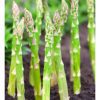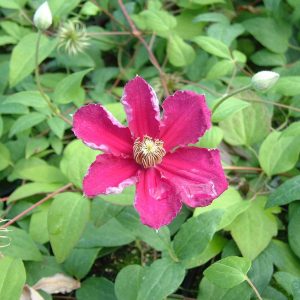Description
Asparagus officinalis ‘Millennium’ is a beautiful and delicious cultivar of asparagus that produces tender and flavorful spears that can be harvested in the spring and early summer. This perennial vegetable is known for its long-lived and vigorous growth, which can provide an abundant harvest for up to 20 years. ‘Millennium’ is a hardy and productive variety that thrives in full sun to partial shade and well-drained soil that’s rich in organic matter. It’s also resistant to rust and other common asparagus diseases, making it an ideal choice for gardeners who want to grow their own fresh and healthy produce. To complement Asparagus officinalis ‘Millennium’, consider planting it alongside other vegetables like tomatoes or lettuce, or herbs like parsley or thyme. It also pairs well with companion plants like marigolds or nasturtiums, which can help to deter pests and attract beneficial insects. Overall, Asparagus officinalis ‘Millennium’ is a delicious and easy-to-grow vegetable that will add a touch of beauty and flavor to any garden. Its tender and flavorful spears, along with its hardy and disease-resistant nature, make it an excellent choice for gardeners who want to enjoy fresh and healthy produce for years to come.
Key Facts
- Common Name(s):asparagus ‘Millennium’
- Hardiness:Fully hardy
- How big will I get? Asparagus officinalis ‘Millennium’ can grow to a height of 1m and a spread of 0.8m.
- Did You Know That:Asparagus spears grow very quickly and can grow up to 10 inches in a day under ideal conditions?
Plant Calendar
A rough guide to how this plant will change through the year.
| Jan | Feb | Mar | Apr | May | June | July | Aug | Sept | Oct | Nov | Dec | |
| Foliage Colour |  |
 |
 |
 |
 |
 |
 |
 |
 |
| J | F | M | A | M | J | J | A | S | O | N | D |
 |
 |
 |
 |
 |
 |
 |
 |
 |
Care Guide

Soil Requirements
Asparagus officinalis ‘Millennium’ prefers soil with good drainage and does not tolerate standing water. This plant is not tolerant of acidic soil, it requires either a neutral or alkaline soil to grow.

Best Position
Asparagus officinalis ‘Millennium’ prefers a sheltered position and requires full sun to thrive, this consists of more than six hours of direct sunshine per day.

Maintenance
Asparagus officinalis ‘Millennium’ should be cut back in the autumn will promote growth the following year by redirecting energy from seed production and foliage maintenance to root growth.

Pest, Diseases and Wildlife
Asparagus officinalis ‘Millennium’ can have problems with slugs and snails, it can be vulnerable to certain diseases such as root rots. It is also known to attract bees, butterflies and other pollinators. It is not considered to be toxic.





